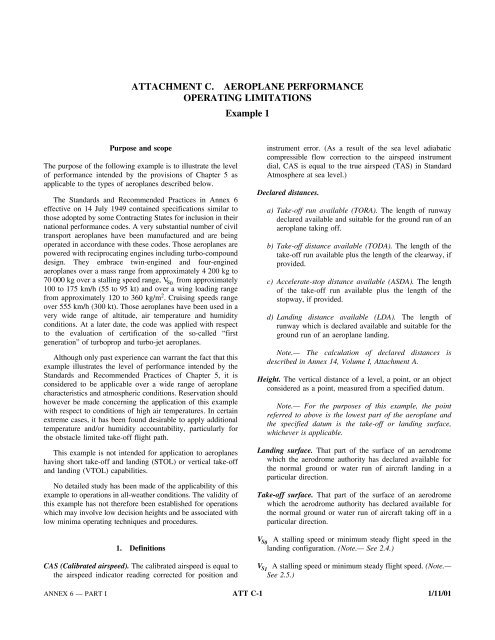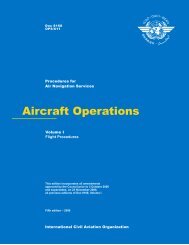Operation of Aircraft
Annex 6, Part I
Annex 6, Part I
- No tags were found...
You also want an ePaper? Increase the reach of your titles
YUMPU automatically turns print PDFs into web optimized ePapers that Google loves.
ATTACHMENT C. AEROPLANE PERFORMANCE<br />
OPERATING LIMITATIONS<br />
Example 1<br />
Purpose and scope<br />
The purpose <strong>of</strong> the following example is to illustrate the level<br />
<strong>of</strong> performance intended by the provisions <strong>of</strong> Chapter 5 as<br />
applicable to the types <strong>of</strong> aeroplanes described below.<br />
The Standards and Recommended Practices in Annex 6<br />
effective on 14 July 1949 contained specifications similar to<br />
those adopted by some Contracting States for inclusion in their<br />
national performance codes. A very substantial number <strong>of</strong> civil<br />
transport aeroplanes have been manufactured and are being<br />
operated in accordance with these codes. Those aeroplanes are<br />
powered with reciprocating engines including turbo-compound<br />
design. They embrace twin-engined and four-engined<br />
aeroplanes over a mass range from approximately 4 200 kg to<br />
70 000 kg over a stalling speed range, V S 0<br />
from approximately<br />
100 to 175 km/h (55 to 95 kt) and over a wing loading range<br />
from approximately 120 to 360 kg/m 2 . Cruising speeds range<br />
over 555 km/h (300 kt). Those aeroplanes have been used in a<br />
very wide range <strong>of</strong> altitude, air temperature and humidity<br />
conditions. At a later date, the code was applied with respect<br />
to the evaluation <strong>of</strong> certification <strong>of</strong> the so-called “first<br />
generation” <strong>of</strong> turboprop and turbo-jet aeroplanes.<br />
Although only past experience can warrant the fact that this<br />
example illustrates the level <strong>of</strong> performance intended by the<br />
Standards and Recommended Practices <strong>of</strong> Chapter 5, it is<br />
considered to be applicable over a wide range <strong>of</strong> aeroplane<br />
characteristics and atmospheric conditions. Reservation should<br />
however be made concerning the application <strong>of</strong> this example<br />
with respect to conditions <strong>of</strong> high air temperatures. In certain<br />
extreme cases, it has been found desirable to apply additional<br />
temperature and/or humidity accountability, particularly for<br />
the obstacle limited take-<strong>of</strong>f flight path.<br />
This example is not intended for application to aeroplanes<br />
having short take-<strong>of</strong>f and landing (STOL) or vertical take-<strong>of</strong>f<br />
and landing (VTOL) capabilities.<br />
No detailed study has been made <strong>of</strong> the applicability <strong>of</strong> this<br />
example to operations in all-weather conditions. The validity <strong>of</strong><br />
this example has not therefore been established for operations<br />
which may involve low decision heights and be associated with<br />
low minima operating techniques and procedures.<br />
1. Definitions<br />
CAS (Calibrated airspeed). The calibrated airspeed is equal to<br />
the airspeed indicator reading corrected for position and<br />
instrument error. (As a result <strong>of</strong> the sea level adiabatic<br />
compressible flow correction to the airspeed instrument<br />
dial, CAS is equal to the true airspeed (TAS) in Standard<br />
Atmosphere at sea level.)<br />
Declared distances.<br />
a) Take-<strong>of</strong>f run available (TORA). The length <strong>of</strong> runway<br />
declared available and suitable for the ground run <strong>of</strong> an<br />
aeroplane taking <strong>of</strong>f.<br />
b) Take-<strong>of</strong>f distance available (TODA). The length <strong>of</strong> the<br />
take-<strong>of</strong>f run available plus the length <strong>of</strong> the clearway, if<br />
provided.<br />
c) Accelerate-stop distance available (ASDA). The length<br />
<strong>of</strong> the take-<strong>of</strong>f run available plus the length <strong>of</strong> the<br />
stopway, if provided.<br />
d) Landing distance available (LDA). The length <strong>of</strong><br />
runway which is declared available and suitable for the<br />
ground run <strong>of</strong> an aeroplane landing.<br />
Note.— The calculation <strong>of</strong> declared distances is<br />
described in Annex 14, Volume I, Attachment A.<br />
Height. The vertical distance <strong>of</strong> a level, a point, or an object<br />
considered as a point, measured from a specified datum.<br />
Note.— For the purposes <strong>of</strong> this example, the point<br />
referred to above is the lowest part <strong>of</strong> the aeroplane and<br />
the specified datum is the take-<strong>of</strong>f or landing surface,<br />
whichever is applicable.<br />
Landing surface. That part <strong>of</strong> the surface <strong>of</strong> an aerodrome<br />
which the aerodrome authority has declared available for<br />
the normal ground or water run <strong>of</strong> aircraft landing in a<br />
particular direction.<br />
Take-<strong>of</strong>f surface. That part <strong>of</strong> the surface <strong>of</strong> an aerodrome<br />
which the aerodrome authority has declared available for<br />
the normal ground or water run <strong>of</strong> aircraft taking <strong>of</strong>f in a<br />
particular direction.<br />
V S 0<br />
. A stalling speed or minimum steady flight speed in the<br />
landing configuration. (Note.— See 2.4.)<br />
V S 1<br />
. A stalling speed or minimum steady flight speed. (Note.—<br />
See 2.5.)<br />
ANNEX 6 — PART I ATT C-1 1/11/01












